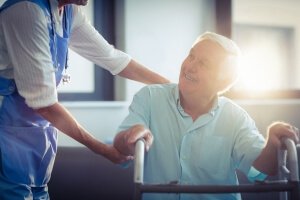
6 Fall Prevention Methods Used by Senior Communities
One of the biggest challenges facing assisted living facilities is the prevention of falls. Falls continue to be the leading cause of both fatal and nonfatal injuries in older adults. A hip or spine fracture, head injury, or broken arm can all result in a major setback, or even death, and can eliminate a person’s choice when it comes to their housing options.
At CarePatrol, we conduct thorough Care Discoveries that help us evaluate an older adult’s need for assisted living, memory care, or in-home care. For some, the evaluation suggests it's time to move to a senior community.
Falls can happen at home or in senior communities, but communities take important and continued measures to mitigate that risk. With a comprehensive fall prevention plan in place, a community can greatly improve the health and well-being of those they serve. It is more important now than ever that senior communities strive to protect their residents from undue harm.
Here are six ways that senior communities help prevent falls:
- They encourage exercise and activity, and staying active can reduce fall risk.
- Stairs are eliminated, proper lighting is installed, and surfaces are maintained to reduce slipping and tripping hazards.
- Bathrooms are equipped with roll-in showers, grab bars, shower chairs, and non-slip surfaces. Clutter is kept out of common areas. Night lights guide residents to the bathroom. Rugs are either secured to the floor or removed altogether.
- Meals are provided to maintain residents’ proper hydration, strength, and energy.
- Medications are managed to make sure they are taken on schedule, prescriptions are refilled, and side effects are monitored by professionals.
- In case of a fall, pull cords, pendants, and motion tracking devices can be used to call for help.
CarePatrol's mission is to help older adults and their families find safer living options. Call your local CarePatrol advisor today!
